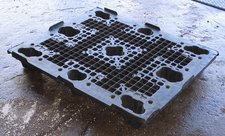Pallet
|
|
- For the fictional town in the Pokémon series of games, named after an artist's palette, see Pallet Town.
A pallet is a flat transport structure made of wood or plastic (and in a few cases metal) which can support a variety of goods in a stable fashion while being lifted by any mobile forklift device. The goods are placed on top of the pallet, and can be secured to it by straps or stretch-wrapped plastic film.
The most common ISO standard pallet measures 100 by 120 by 12 cm (slightly less than 40 inches by 48 inches by 5 inches). It weighs 15 to 21 kilograms empty. Most pallets can easily carry a load of 1,000 kg. The gradual advent of containers for the transport of nearly all goods has spurred the use of pallets because the containers always offer the clean, level surfaces needed to make pallet movement economical. The common ISO standard pallets also fit neatly into common ISO containers, which in turn fit neatly on container ships, trains and trucks.
In Europe an EUR standard pallet is commonly used and measures 80 by 120 by 12 cm. It is also called a CEN (Comité Européen de Normalisation - European Committee for Standardisation) pallet and it is used mainly for retail business, its size having been determined by the internal dimensions of trucks making deliveries from warehouses to retail establishments.
The cheapest pallets are made of softwood and are often considered as expendable, to be discarded as trash, along with other wrapping elements, upon reaching destination. These pallets are of a very simple construction which permits lifting from one of two opposite positions only. Slightly more complex hardwood pallets and most plastic pallets and metal pallets can be lifted from all four sides. These costlier pallets usually require a deposit and are returned to the sender or resold as used. Many of these "four way" pallets are color coded according to the loads they can bear, and other attributes.
Businesses in retail or manufacturing with accommodations for loading and unloading standard sized pallets and internal procedures for taking advantages of the modular nature of the pallets usually have a distinct advantage over businesses which do not exploit standardized pallets. The exceptions are those establishments which sell small quantities of luxury items such as jewelry stores or extra large items such as cars. But even they are at least indirectly affected. For instance, the distributors of costume jewelry and like items would normally use pallets in their warehouses and car manufacturers have long ago integrated pallets in their logistics systems for transporting components from their suppliers and for moving around spare parts.
One of the greatest advantages of pallets is the number of ways they can be moved around. They can be hauled by forklift trucks of different sizes and they can also be transported by hand-pumped and hand-drawn jacks which require no more than muscle power, wherever a solid and even clean floor with enough room is available. A forklift truck often costs the same as a luxury automobile but a good reconditioned hand-drawn "pumper" jack can be gotten for a few hundred euros. The greatest investment is thus in the time it takes to plan for clearances and level surfaces in the construction of commercial or industrial buildings where the use of pallets could be economical.
Related topics
- ULD, lightweight pallet or container for aircraft.de:Transportpalette



